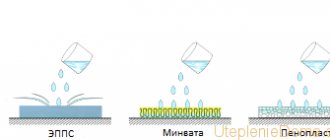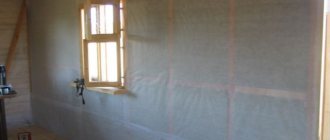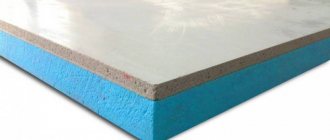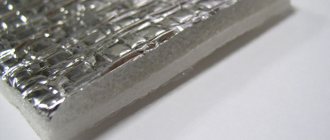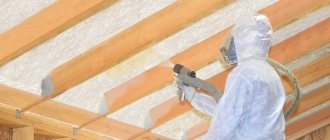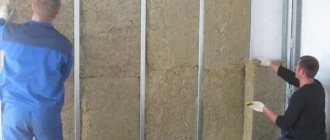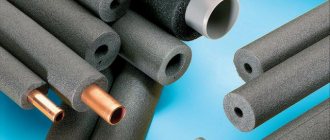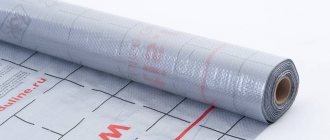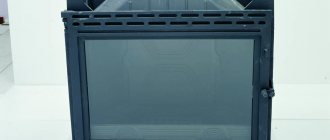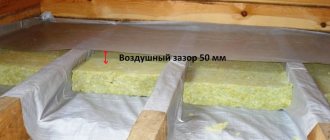Table of densities of different insulation materials
The density of insulation is the value that determines the mass of one cubic meter of material. This indicator differs for different thermal insulation materials.
| Name | kg/m³ |
| Cellulose wool | 30-70 |
| Fiberboard | 150-230 |
| Linen mats | 30 |
| Foam glass | 100-150 |
| Cotton wadding | 25-30 |
| Mineral wool | 50-200 |
| Styrofoam | 25-35 |
| Extruded polystyrene foam | 35-40 |
| Polyurethane foam | 30-80 |
| Expanded clay | 450-1200 |
This insulation parameter is determined by the purpose of the thermal insulation.
Structural materials and their thermal conductivity
The thermal conductivity of a substance depends on its density. The greater the density of the substance, the higher the thermal conductivity. As porosity increases, its coefficient decreases.
The low thermal conductivity coefficient of the material determines its good thermal insulation qualities.
Concrete
- Density: 500 kg/m³–2,500 kg/m³. The indicator depends on the composition of the mixture.
- Thermal conductivity: 1.28–1.51 W/m*K. The indicator varies depending on the consistency of the concrete.
Concrete mixture is used to pour a monolithic foundation, and concrete blocks are used to lay the foundation and erect walls.
Reinforced concrete
- Density: 2,500 kg/m3; concrete mixture without vibration (use of deep vibrator) – 2,400 kg/m3.
- Thermal conductivity: 1.69 W/m*K.
Lightweight concrete with porous aggregates is called cellular concrete.
Used as a structural and thermal insulation material. The most common building materials made of concrete with porous aggregates are aerated concrete, foam concrete, and expanded clay concrete.
These materials are used for the construction of multi-story, private houses and for additional extensions: bathhouses, garages, sheds.
Expanded clay concrete
Solid expanded clay concrete blocks are produced using vibrocompression. They do not have voids or holes. Often used for laying load-bearing walls or laying foundations.
Hollow expanded clay concrete blocks are made using special molds that allow the formation of sealed or through voids when pouring the mixture.
They have less strength compared to solid expanded clay concrete blocks. They have lower thermal conductivity, which makes them an optimal material for the construction of lightweight structures with the required high thermal insulation.
- Density: 500 kg/m³–1,800 kg/m³.
- Thermal conductivity: 0.14–0.66 W/m*K.
Aerated concrete
Made from gas silicate. Using specialized gas generators, approximately spherical pores (voids) are formed inside the block, their diameter is 1–3 mm.
- Density: 300–800 kg/m3. Depends on the number and size of voids.
- Thermal conductivity: 0.1–0.3 W/m*K.
Foam concrete
Manufactured using foaming additives. It has a porous structure.
- Density: 600–1,000 kg/m3.
- Thermal conductivity: 0.1–0.38 W/m*K.
Adobe brick
Made from clay and filler.
- Density: 500 kg/m³–1,900 kg/m³;
- Thermal conductivity: 0.1–0.4 W/m*K.
Ceramic brick
Made from baked clay.
- Density: solid – 1,600 kg/m³–1,900 kg/m³; hollow – 1,100 kg/m³–1,400 kg/m³;
- Thermal conductivity: solid – 0.56–0.86 W/m*K; hollow–0.35–0.41 W/m*K.
Sand-lime brick
Made from sand and lime.
- Density: 1,100 kg/m³–1,900 kg/m³;
- Thermal conductivity: 0.81–0.87 W/m*K.
Tree
- Density: 150 kg/m³–2,100 kg/m³;
- Thermal conductivity: 0.2–0.23 W/m*K.
Building structural materials, even with low thermal conductivity, require additional insulation.
Or read HERE about permanent polystyrene foam formwork.
Density and its influence on material properties
Since thermal insulation material has different densities, there are several types:
- especially light;
- easy;
- average;
- dense (hard).
Density affects the following indicators:
- thermal conductivity;
- noise absorption;
- load-bearing capacity;
- installation method.
In any thermal insulation material, air is the main thermal insulating component. It can be in a natural or discharged state. The better it is insulated from the environment and the more it is contained in the insulation, the higher the thermal conductivity of the material.
The lower the air permeability of the insulation, the better it absorbs noise. Thermal insulation material, which has an increased density, will better absorb sound even if this is not its main purpose. But since in some insulation the density reaches 150 kg/m³, there is a large load on the floor structure. Therefore, it is better to purchase specialized sound-absorbing material.
Insulation that is too light cannot be used in areas that will be subject to high loads. With low strength characteristics, the material will deform. Therefore, it is necessary to use thermal insulation with a density of at least 150 kg/m³.
Advantages and disadvantages
When choosing thermal insulation, you need to take into account not only its physical properties, but also parameters such as ease of installation, the need for additional maintenance, durability and cost.
Comparison of the most modern options
As practice shows, the easiest way to install polyurethane foam and penoizol, which are applied to the surface to be treated in the form of foam. These materials are plastic; they easily fill cavities inside the walls of a building. The disadvantage of foaming substances is the need to use special equipment to spray them.
As the table above shows, extruded polystyrene foam is a worthy competitor to polyurethane foam. This material is supplied in the form of solid blocks, but with the help of a regular carpenter's knife it can be cut into any shape. Comparing the characteristics of foam and solid polymers, it is worth noting that foam does not form seams, and this is its main advantage compared to blocks.
Comparison of cotton materials
Mineral wool is similar in properties to foam plastics and expanded polystyrene, but it “breathes” and does not burn. It also has better resistance to moisture and practically does not change its qualities during operation. If you have a choice between solid polymers and mineral wool, it is better to give preference to the latter.
Stone wool has the same comparative characteristics as mineral wool, but the cost is higher. Ecowool has a reasonable price and is easy to install, but it has low compressive strength and sags over time. Fiberglass also sags and, in addition, crumbles.
Bulk and organic materials
Bulk materials such as perlite and paper granules are sometimes used to insulate a house. They repel water and are resistant to pathogenic factors. Perlite is environmentally friendly, it does not burn and does not settle. However, bulk materials are rarely used to insulate walls; it is better to use them to equip floors and ceilings.
Among organic materials, it is necessary to highlight flax, wood fiber and cork. They are safe for the environment, but are susceptible to burning if not impregnated with special substances. In addition, wood fiber is susceptible to biological factors.
In general, if we take into account the cost, practicality, thermal conductivity and durability of insulation, the best materials for finishing walls and ceilings are polyurethane foam, penoizol and mineral wool. Other types of insulation have specific properties, since they are designed for non-standard situations, and the use of such insulation is recommended only if there are no other options.
Selecting insulation density
Before deciding which insulation density to choose, you need to determine where it will be installed. If you plan to insulate the walls, the type of cladding plays an important role. It determines the type and density of the heat insulator. Thus, for a residential building it is recommended to use basalt wool, which has low thermal conductivity, high fire resistance and environmental friendliness.
For cladding with siding, a basalt heat insulator with values of 40-90 kg/m³ is suitable. The higher the thermal insulation is located, the higher the indicator should be. If the surface will be plastered, then you need to choose special thermal insulation for facade work. The density should be 140-160 kg/m³. For this work, special elements are used that have high vapor permeability and tear strength. For interior work, low-density thermal insulation material is used.
When doing roofing work, the choice of insulation depends on the type of roof. If the roof is pitched, choose insulation with values of 30-45 kg/m³. To insulate the attic, the indicator must be at least 35-40 kg/m³. A flat roof must withstand heavy loads caused by snow, wind and other atmospheric phenomena. Therefore, in this case, thermal insulation with a density of 150 kg/m³ should be used if mineral wool is used. For expanded polystyrene, this figure should be no more than 40 kg/m³.
To insulate the floor from the cold, you should choose a material whose mass pressure per unit volume is sufficiently high. However, if you plan to lay material between the joists, you can use loose insulation. The logs take on the entire load, and the thermal insulation is not tasked with withstanding the pressure exerted.
Thermal conductivity indicators for finished buildings. Types of insulation
When creating a project, you need to consider all ways of heat leakage. It can come out through walls and roofs, as well as through floors and doors. If you carry out design calculations incorrectly, you will have to be content only with the thermal energy received from heating devices. Buildings built from standard raw materials: stone, brick or concrete need to be additionally insulated.
Installation of mineral wool
Additional thermal insulation is carried out in frame buildings. At the same time, a wooden frame gives rigidity to the structure, and insulating material is laid in the space between the posts. In buildings made of brick and cinder blocks, insulation is done from the outside of the structure.
When choosing insulation materials, you need to pay attention to factors such as humidity levels, the influence of elevated temperatures and the type of structure. Consider certain parameters of insulating structures:
- the thermal conductivity indicator affects the quality of the heat-insulating process;
- moisture absorption is of great importance when insulating external elements;
- thickness affects the reliability of insulation. Thin insulation helps preserve the usable area of the room;
- Flammability is important. High-quality raw materials have the ability to self-extinguish;
- thermal stability reflects the ability to withstand temperature changes;
- environmental friendliness and safety;
- Sound insulation protects against noise.
Characteristics of different types of insulation
The following types of insulation are used:
- mineral wool is fire resistant and environmentally friendly. Important characteristics include low thermal conductivity;
This material is one of the most affordable and simplest options.
- polystyrene foam is a lightweight material with good insulating properties. It is easy to install and is moisture resistant. Recommended for use in non-residential buildings;
- basalt wool, unlike mineral wool, has better resistance to moisture;
- Penoplex is resistant to humidity, elevated temperatures and fire. It has excellent thermal conductivity, is easy to install and durable;
Penoplex is characterized by a porous structure
- polyurethane foam is known for such qualities as non-flammability, good water-repellent properties and high fire resistance;
- Extruded polystyrene foam undergoes additional processing during production. Has a uniform structure;
This option comes in different thicknesses
- penofol is a multi-layer insulating layer. The composition contains foamed polyethylene. The surface of the plate is covered with foil to provide reflection.
Bulk types of raw materials can be used for thermal insulation. These are paper granules or perlite. They are resistant to moisture and fire. And among organic varieties, you can consider wood fiber, flax or cork. When choosing, pay special attention to such indicators as environmental friendliness and fire safety.
Note! When designing thermal insulation, it is important to consider the installation of a waterproofing layer. This will avoid high humidity and increase resistance to heat transfer.
Insulation materials and their thermal conductivity
They are used to insulate the foundation, floor, building walls inside and outside, ceiling and roof.
Styrofoam
- Density: 15 kg/m³–50 kg/m³;
- Thermal conductivity: 0.31–0.33 W/m*K.
Expanded polystyrene
- Density: 15 kg/m³–50 kg/m³;
- Thermal conductivity: 0.028–0.035 W/m*K.
Mineral wool
Mineral wool has the ability to absorb moisture. Water easily accumulates, but it takes a very long time to evaporate from this sound and heat insulation material.
If mineral wool becomes oversaturated with moisture, it will lose its basic insulating properties. To prevent moisture absorption, the mineral wool is hermetically sealed on both sides with a layer of waterproofing.
Glass wool
- Density: 15 kg/m³–45 kg/m³;
- Thermal conductivity: 0.038–0.046 W/m*K.
Basalt (stone) wool
- Density: 30 kg/m³–200 kg/m³;
- Thermal conductivity: 0.035–0.042 W/m*K.
Ecowool
- Density: 30 kg/m³–110 kg/m³;
- Thermal conductivity: 0.032–0.041 W/m*K.
The comparative characteristics of the thermal conductivity of structural building materials and insulation materials must be analyzed, choosing the most suitable material for construction or additional thermal insulation.
